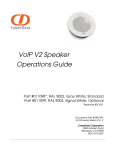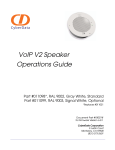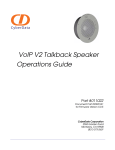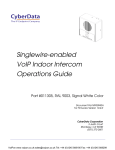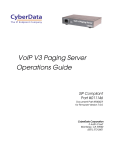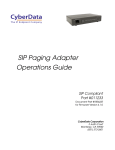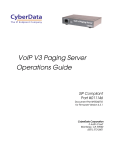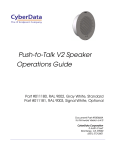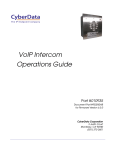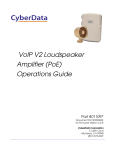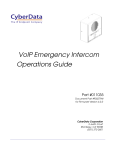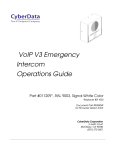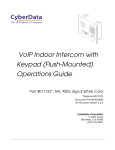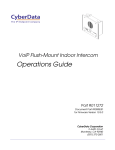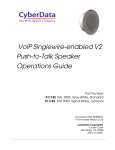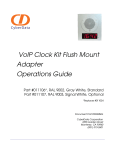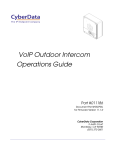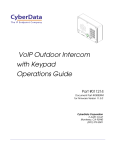Download CyberData 021037C Product specifications
Transcript
The IP Endpoint Company VoIP V2 Speaker Operations Guide Part #011098*, RAL 9002, Gray White, Standard Part #011099, RAL 9003, Signal White, Optional *Replaces #011021 Document Part #930274R for Firmware Version 6.3.0 CyberData Corporation 3 Justin Court Monterey, CA 93940 (831) 373-2601 VoIP V2 Speaker Operations Guide 930274R Part # 011098* Part # 011099 *Replaces 011021 COPYRIGHT NOTICE: © 2014, CyberData Corporation, ALL RIGHTS RESERVED. This manual and related materials are the copyrighted property of CyberData Corporation. No part of this manual or related materials may be reproduced or transmitted, in any form or by any means (except for internal use by licensed customers), without prior express written permission of CyberData Corporation. This manual, and the products, software, firmware, and/or hardware described in this manual are the property of CyberData Corporation, provided under the terms of an agreement between CyberData Corporation and recipient of this manual, and their use is subject to that agreement and its terms. DISCLAIMER: Except as expressly and specifically stated in a written agreement executed by CyberData Corporation, CyberData Corporation makes no representation or warranty, express or implied, including any warranty or merchantability or fitness for any purpose, with respect to this manual or the products, software, firmware, and/or hardware described herein, and CyberData Corporation assumes no liability for damages or claims resulting from any use of this manual or such products, software, firmware, and/or hardware. CyberData Corporation reserves the right to make changes, without notice, to this manual and to any such product, software, firmware, and/or hardware. OPEN SOURCE STATEMENT: Certain software components included in CyberData products are subject to the GNU General Public License (GPL) and Lesser GNU General Public License (LGPL) “open source” or “free software” licenses. Some of this Open Source Software may be owned by third parties. Open Source Software is not subject to the terms and conditions of the CyberData COPYRIGHT NOTICE or software licenses. Your right to copy, modify, and distribute any Open Source Software is determined by the terms of the GPL, LGPL, or third party, according to who licenses that software. Software or firmware developed by CyberData that is unrelated to Open Source Software is copyrighted by CyberData, subject to the terms of CyberData licenses, and may not be copied, modified, reverse-engineered, or otherwise altered without explicit written permission from CyberData Corporation. TRADEMARK NOTICE: CyberData Corporation and the CyberData Corporation logos are trademarks of CyberData Corporation. Other product names, trademarks, and service marks may be the trademarks or registered trademarks of their respective owners. Technical Support The IP Endpoint Company The fastest way to get technical support for your VoIP product is to submit a VoIP Technical Support form at the following website: http://www.cyberdata.net/support/contactsupportvoip.php Phone: (831) 373-2601, Ext. 333 Email: [email protected] Fax: (831) 373-4193 Company and product information is at www.cyberdata.net. CyberData Corporation 930274R Operations Guide Revision Information Revision 930274R, which corresponds to firmware version 6.3.0, was updated on April 4, 2014 and has the following changes: Operations Guide • Adds the following warning to the following sections: • Important Safety Instructions • Section 1.2, "Installation" • Section Appendix A:, "Mounting the Speaker" • Warning Text: “The PoE connector is intended for intra-building connections only and does not route to the outside plant.” 930274R CyberData Corporation Pictorial Alert Icons GENERAL ALERT General Alert This pictoral alert indicates a potentially hazardous situation. This alert will be followed by a hazard level heading and more specific information about the hazard. Ground This pictoral alert indicates the Earth grounding connection point. Hazard Levels Danger: Indicates an imminently hazardous situation which, if not avoided, will result in death or serious injury. This is limited to the most extreme situations. Warning: Indicates a potentially hazardous situation which, if not avoided, could result in death or serious injury. Caution: Indicates a potentially hazardous situation which, if not avoided, could result in minor or moderate injury. It may also alert users against unsafe practices. Notice: Indicates a statement of company policy (that is, a safety policy or protection of property). The safety guidelines for the equipment in this manual do not purport to address all the safety issues of the equipment. It is the responsibility of the user to establish appropriate safety, ergonomic, and health practices and determine the applicability of regulatory limitations prior to use. Potential safety hazards are identified in this manual through the use of words Danger, Warning, and Caution, the specific hazard type, and pictorial alert icons. CyberData Corporation 930274R Operations Guide Important Safety Instructions 1. Read these instructions. 2. Keep these instructions. 3. Heed all warnings. 4. Follow all instructions. 5. Do not use this apparatus near water. 6. Clean only with dry cloth. 7. Do not block any ventilation openings. Install in accordance with the manufacturer’s instructions. 8. Do not install near any heat sources such as radiators, heat registers, stoves, or other apparatus (including amplifiers) that produce heat. 9. Do not defeat the safety purpose of the polarized or grounding-type plug. A polarized plug has two blades with one wider than the other. A grounding type plug has two blades and a third grounding prong. The wide blade or the third prong are provided for your safety. If the provided plug does not fit into your outlet, consult an electrician for replacement of the obsolete outlet. 10. Protect the power cord from being walked on or pinched particularly at plugs, convenience receptacles, and the point where they exit from the apparatus. 11. Only use attachments/accessories specified by the manufacturer. 12. Refer all servicing to qualified service personnel. Servicing is required when the apparatus has been damaged in any way, such as power-supply cord or plug is damaged, liquid has been spilled or objects have fallen into the apparatus, the apparatus has been exposed to rain or moisture, does not operate normally, or has been dropped. 13. Prior to installation, consult local building and electrical code requirements. 14. WARNING: The VoIP V2 Speaker enclosure is not rated for any AC voltages! Warning Electrical Hazard: This product should be installed by a licensed electrician according to all local electrical and building codes. GENERAL ALERT Warning Electrical Hazard: To prevent injury, this apparatus must be securely attached to the floor/wall in accordance with the installation instructions. GENERAL ALERT Warning The PoE connector is intended for intra-building connections only and does not route to the outside plant. GENERAL ALERT CyberData Corporation 930274R Operations Guide Abbreviations and Terms Abbreviation or Term Definition A-law A standard companding algorithm, used in European digital communications systems to optimize, i.e., modify, the dynamic range of an analog signal for digitizing. AVP Audio Video Profile Cat 5 TIA/EIA-568-B Category 5 DHCP Dynamic Host Configuration Protocol LAN Local Area Network LED Light Emitting Diode Mbps Megabits per Second. NTP Network Time Protocol PBX Private Branch Exchange PoE Power over Ethernet (as per IEEE 802.3af standard) RTFM Reset Test Function Management SIP Session Initiated Protocol u-law A companding algorithm, primarily used in the digital telecommunication UC Unified Communications VoIP Voice over Internet Protocol CyberData Corporation 930274R Operations Guide i Contents Chapter 1 Product Overview 1 1.1 How to Identify This Product .....................................................................................................1 1.2 Installation ................................................................................................................................2 1.3 Product Features ......................................................................................................................3 1.4 Supported Protocols .................................................................................................................4 1.5 Supported SIP Servers .............................................................................................................4 1.6 Product Specifications ..............................................................................................................5 1.7 Optional Connections (J9 and J10) ..........................................................................................6 1.8 Dimensions ...............................................................................................................................6 Chapter 2 Installing the VoIP V2 Speaker 7 2.1 Parts List ..................................................................................................................................7 2.2 Device Configuration ................................................................................................................8 2.2.1 Connect Power to the Speaker ......................................................................................9 2.2.2 Installation Options .......................................................................................................12 2.2.3 Confirm that the Speaker is Operational and Linked to the Network ..........................16 2.2.4 Confirm the IP Address and Test the Audio .................................................................17 2.2.5 Adjust the Volume ........................................................................................................18 2.2.6 How to Set the Factory Default Settings .......................................................................19 2.3 Configure the Speaker Parameters .......................................................................................20 2.3.1 Default IP Settings ........................................................................................................20 2.3.2 V2 Speaker Web Page Navigation ...............................................................................21 2.3.3 Log in to the Configuration Home Page .......................................................................22 2.3.4 Configure the Device Parameters ................................................................................25 2.3.5 Configure the Network Parameters ..............................................................................27 2.3.6 Configure the SIP Parameters .....................................................................................29 2.3.7 Configure the Night Ringer Parameters .......................................................................32 2.3.8 Configure the Multicast Parameters .............................................................................34 2.3.9 Configure the Audio Parameters ..................................................................................37 2.3.10 Configure the NTP Server and Clock Parameters ......................................................43 2.3.11 Configure the Event Parameters ................................................................................48 2.3.12 Configure the Autoprovisioning Parameters ...............................................................53 2.3.13 Upgrade the Firmware and Reboot the V2 Speaker ..................................................58 2.4 Command Interface ................................................................................................................63 2.4.1 Command Interface Post Commands ..........................................................................63 Appendix A Mounting the Speaker 66 A.1 Important Safety Instructions .................................................................................................66 A.2 Mount the Speaker ................................................................................................................67 Appendix B Setting up a TFTP Server 70 B.1 Set up a TFTP Server ............................................................................................................70 B.1.1 Autoprovisioning requires a TFTP server for hosting the configuration file. .................70 B.1.2 In a LINUX Environment ..............................................................................................70 B.1.3 In a Windows Environment .........................................................................................70 Appendix C Troubleshooting/Technical Support 71 C.1 Frequently Asked Questions (FAQ) ........................................................................................71 C.2 Documentation .......................................................................................................................71 C.3 Contact Information ................................................................................................................72 C.4 Warranty .................................................................................................................................73 C.4.1 Warranty & RMA Returns within the United States ......................................................73 C.4.2 Warranty & RMA Returns outside of the United States ...............................................73 C.4.3 Spare in the Air Policy ..................................................................................................74 Operations Guide 930274R CyberData Corporation C.4.4 Return and Restocking Policy ......................................................................................74 C.4.5 Warranty and RMA Returns Page ...............................................................................74 Index Operations Guide 75 930274R CyberData Corporation 1 1 Product Overview The CyberData SIP-enabled V2 Speaker is a Power-over-Ethernet (PoE 802.3af) and Voice-over-IP (VoIP) public address loudspeaker that easily connects into existing local area networks with a single CAT5 cable connection. The speaker is compatible with most SIP-based IP PBX. In a non-SIP environment, the speaker is capable of receiving broadcast audio via multicast. Its small footprint and low height allows the speaker to be discretely mounted almost anywhere. 1.1 How to Identify This Product To identify the VoIP V2 Speaker, look for a model number label similar to the one shown in Figure 1-1. The model number on the label should be one of the following: • 011098*, RAL 9002, Gray White, Standard Color • 011099, RAL 9003, Signal White, Optional Color *Replaces 011021. Figure 1-1. Model Number Label WWW.CYBERDATA.NET SPEAKER,V2,VoIP INDOOR PAGING, CEILING/WALL MOUNTED, RoHS 011098A / 021037C 098000001 Model number Operations Guide 930274R CyberData Corporation Product Overview 2 Installation 1.2 Installation Note Prior to installation, create a plan for the locations of your speakers. Warning Electrical Hazard: The VoIP V2 Speaker enclosure is not rated for any AC voltages. GENERAL ALERT Warning Electrical Hazard: This product should be installed by a licensed electrician according to all local electrical and building codes. GENERAL ALERT Warning Electrical Hazard: To prevent injury, this apparatus must be securely attached to the floor/wall in accordance with the installation instructions. GENERAL ALERT Warning The PoE connector is intended for intra-building connections only and does not route to the outside plant. GENERAL ALERT General Alert Consult local building and electrical code requirements prior to installation. GENERAL ALERT Operations Guide 930274R CyberData Corporation Product Overview 3 Product Features Figure 1-2 illustrates a typical configurations for the VoIP V2 Speaker. Figure 1-2. Typical Installation 802.3af Compliant Ethernet Switch 1 Speaker Speaker 2 3 4 5 6 IP Phone Clock Kit IP PBX Server See the following sections for other installation options: • Section 2.2.1.3, "Running the V2 Speaker with Auxiliary Power" • Section 2.2.2.1, "V2 Speaker with an External Device" • Section 2.2.2.2, "V2 Speaker with Auxiliary Speaker Connection" • Section 2.2.2.3, "V2 Speaker with Line Out" 1.3 Product Features Operations Guide 930274R • SIP (RFC 3261) compatible • Web-based configuration • Web-based firmware upgradeable • Autoprovisioning support • Small footprint • High efficiency speaker driver • PoE 802.3af Enabled (Powered-overEthernet) • Network and external speaker volume control • Peer-to-peer capability • User-uploadable ring and alert tones • Auto detect for CyberData Clock kit • Nightringer • Buffered page CyberData Corporation Product Overview 4 Supported Protocols 1.4 Supported Protocols The V2 Speaker supports: • SIP • Multicast • HTTP Web-based configuration Provides an intuitive user interface for easy system configuration and verification of speaker operations. • DHCP Client Dynamically assigns IP addresses in addition to the option to use static addressing. • HTTP TCP Post auto-updating event notification in XML format • TFTP Client Facilitates hosting for the configuration file for Autoprovisioning. • Audio Encodings PCMU (G.711 mu-law) PCMA (G.711 A-law) Packet Time 20 ms 1.5 Supported SIP Servers The following link contains information on how to configure the speaker for the supported SIP servers: http://www.cyberdata.net/support/server/index.html Operations Guide 930274R CyberData Corporation Product Overview 5 Product Specifications 1.6 Product Specifications Table 1-1. Product Specifications Category Specification Audio sensitivity 96dB/1W/1M S.P. Level Audio output 10 Watts Peak Power Operating temperature -30 to 55 C (-22 to 131 F) Ethernet port baud rate 10/100 Mbps Protocol SIP RFC 3261 Compatible Power Input (J1) PoE 802.3af (as per IEEE 802.3af standard from a UL-listed, LPS-rated limited power source) 44-57 VDC (48 VDC nominal) at 350mA or Auxiliary Power Input 12 VDC at 1A (from a UL-listed, LPS-rated power supply) (Terminal Block J10) a Total Power ~ 15W Network Line loss ~ 2W Total Pwr @ VoIP Speaker ~ 13W Total available audio power ~ 10W Idle PWR (losses/CPU) ~ 3W Payload types G711, A-law and µ-law Regulatory compliance FCC Class B, CE Warranty 2 years limited Dimensions 9” x 2.4” Weight 2.8 lbs./shipping weight of 3.8 lbs. (1.3 kg/shipping weight of 1.7 kg) Part number 011098*, RAL 9002, Gray White, Standard Color 011099, RAL 9003, Signal White, Optional Color *Replaces 011021. a.Auxiliary power input for use when PoE power is not available. 12 VDC @ 1A. Do not use auxiliary power input when speaker J1 is connected to a PoE power source. Operations Guide 930274R CyberData Corporation Product Overview 6 Optional Connections (J9 and J10) 1.7 Optional Connections (J9 and J10) Figure 1-3. Optional Connections (J9 and J10) Function J10 Connections *Auxiliary power input for use when PoE power is not available. 12 VDC @ 1A. AUX POWER (+) (+12VDC @ 1A) AUX SPEAKER (-) AUX POWER (-) AUX SPEAKER (+) Relay contacts rated at 30 VDC @ 1A. 5 VDC @ 100 mA. J9 Connections RELAY COM Function Auxiliary 8-Ohm speaker connection (not to be used when the Clock is connected. GND RELAY NO LINE OUT (-) +5V OUT LINE OUT (+) J10 Audio line - level output to external audio amplifier. 2v P-P into 10k Ohms. J9 *Do not use auxiliary power input when speaker J1 is connected to a PoE power source. 1.8 Dimensions Figure 1-4 shows the dimensions for the V2 Speaker. Figure 1-4. Dimensions 3.1 [80] Operations Guide 9.0 [229] Dimensions are in Inches [Millimeter] 930274R CyberData Corporation 7 2 Installing the VoIP V2 Speaker 2.1 Parts List Table 2-1 illustrates the parts for each speaker and includes kits for the drop ceiling and drywall mounting. Note The installation template for the V2 Speaker is located on the Installation Quick Reference Guide that is included in the packaging with each speaker. Table 2-1. Parts Quantity Operations Guide Part Name Illustration 1 V2 Speaker Assembly 1 Installation Quick Reference Guide 1 Speaker Mounting Accessory Kit (Part #070054A) 930274R CyberData Corporation Installing the VoIP V2 Speaker 8 Device Configuration 2.2 Device Configuration Set up and configure each speaker before you mount it. CyberData delivers each speaker with the following factory default values: Table 2-2. Factory Network Default Settings—Default of Network Parameter Factory Default Setting IP Addressing DHCP a IP Address 10.10.10.10 Web Access Username admin Web Access Password admin Subnet Mask Default a 255.0.0.0 Gatewaya 10.0.0.1 a. Default if there is not a DHCP server present. Operations Guide 930274R CyberData Corporation Installing the VoIP V2 Speaker 9 Device Configuration 2.2.1 Connect Power to the Speaker Figure 2-1 through Figure 2-3 illustrates how to connect power to the VoIP V2 Speaker. 2.2.1.1 VoIP V2 Speaker to a 802.3af Compliant PoE Switch Figure 2-1 illustrates how to connect the VoIP V2 Speaker to a 802.3af compliant PoE switch via a Cat 5 Ethernet cable. Figure 2-1. VoIP V2 Speaker to a 802.3af Compliant PoE Switch Cat 5 Ethernet cable 802.3af Compliant PoE Switch VoIP V2 Speaker Operations Guide 930274R CyberData Corporation Installing the VoIP V2 Speaker 10 Device Configuration 2.2.1.2 VoIP V2 Speaker (with PoE Injector) to a 802.3af Compliant PoE Switch In Figure 2-2, if a PoE switch is not available, you will need a PoE Injector, part #010867A (ordered separately). A PoE Injector is a power supply solution for those who have a standard Non PoE Switch. Figure 2-2. VoIP V2 Speaker (with PoE Injector) to a Non PoE Switch PoE Injector (Part #010867A) Cat 5 Ethernet cable Non PoE Switch VoIP V2 Speaker Operations Guide 930274R CyberData Corporation Installing the VoIP V2 Speaker 11 Device Configuration 2.2.1.3 Running the V2 Speaker with Auxiliary Power In Figure 2-3, the power for the V2 Speaker can either come from an 802.3af Network connection or from an external source. Caution GENERAL ALERT Operational Note: Do not connect an auxiliary power supply when the V2 Speaker is connected to a PoE power source through J1. Improper operation or equipment damage may occur. Figure 2-3. Running the V2 Speaker with Auxiliary Power Speaker +12 VDC GND AC adaptor +12 VDC @ 1 Amps (UL-listed, LPS-rated) Operations Guide AUX POWER (+) (+12VDC @ 1A) AUX SPEAKER (-) AUX SPEAKER (+) GND LINE OUT (-) LINE OUT (+) AUX POWER (-) RELAY COM RELAY NO +5V OUT J10 930274R J9 CyberData Corporation Installing the VoIP V2 Speaker 12 Device Configuration 2.2.2 Installation Options This section shows various installation options for the V2 Speaker. 2.2.2.1 V2 Speaker with an External Device In Figure 2-4, when the V2 Speaker is called from a remote phone, the relay on the speaker can be programmed to drive an external device such as an alert strobe. This external device may also be addressed from a separate Unified Communication (UC) server. Figure 2-4. V2 Speaker with Alert Strobe Speaker AUX POWER (+) (+12VDC @ 1A) AUX SPEAKER (-) AUX SPEAKER (+) GND LINE OUT (-) LINE OUT (+) AUX POWER (-) RELAY COM RELAY NO +5V OUT Alert Strobe J10 J9 External Device Such as an Electric Door Strike or Strobe Light AC or DC Power Source as Required by an External Device Operations Guide Output Contacts AC or DC-rated Depending Upon External Device Requirements 930274R CyberData Corporation Installing the VoIP V2 Speaker 13 Device Configuration 2.2.2.2 V2 Speaker with Auxiliary Speaker Connection In Figure 2-5, the V2 Speaker supports an amplified audio output for a second analog speaker. While the total speaker wattage is the same, by connecting a low cost analog speaker, additional coverage can be realized. Caution Operational Note: Because of the limitations of PoE power, when running the V2 Speaker with a second auxiliary speaker, the analog or digital volume level setting must not exceed a setting of 6. GENERAL ALERT Figure 2-5. V2 Speaker with Auxiliary Speaker Connection Speaker High-purity copper 16-gauge wire and a maximum length of 20 feet AUX POWER (+) (+12VDC @ 1A) AUX SPEAKER (-) AUX SPEAKER (+) GND LINE OUT (-) LINE OUT (+) AUX POWER (-) RELAY COM RELAY NO +5V OUT J10 J9 8 Ohm Auxiliary Speaker (Part #011120, RAL 9002) (Part #011121, RAL 9003) *When using the second speaker connection, the analog volume control needs to be disabled. *Because of the limitations of PoE power, when running the V2 Speaker with a second auxiliary speaker, the analog or digital volume level setting must not exceed a setting of 6. Caution GENERAL ALERT Operations Guide Operational Note: You must not use the V2 Speaker in combination with both a Clock Kit and an auxiliary speaker. The V2 Speaker may only be used separately with an auxiliary speaker or used separately with a Clock Kit. See Figure 2-6, "Clock Kit with Extra Speaker Connection is NOT ALLOWED." 930274R CyberData Corporation Installing the VoIP V2 Speaker 14 Device Configuration Figure 2-6. Clock Kit with Extra Speaker Connection is NOT ALLOWED. NOT ALLOWED 16 gauge wire and a maximum length of 20 feet 8 Ohm Analog Speaker (CD Part Number 011072) VoIP Clock Kit (Wall Mount Version) Operations Guide 930274R CyberData Corporation Installing the VoIP V2 Speaker 15 Device Configuration 2.2.2.3 V2 Speaker with Line Out In Figure 2-7, for areas that require more speaker volume, the V2 Speaker can be connected directly to an auxiliary amplifier to drive additional horns or speakers. This is done through the line-out connection. Figure 2-7. V2 Speaker with Line Out Speaker Office area in Factory AUX POWER (+) (+12VDC @ 1A) Line Out: Output Signal Amplitudes 2.0 VPP maximum Output Level +2dBm nominal Total Harmonic Distortion 0.5% maximum Output Impedance 10k ohm AUX SPEAKER (-) AUX SPEAKER (+) GND LINE OUT (-) LINE OUT (+) AUX POWER (-) RELAY COM RELAY NO +5V OUT J10 J9 Amplifier Factory Floor Operations Guide 930274R CyberData Corporation Installing the VoIP V2 Speaker 16 Device Configuration 2.2.3 Confirm that the Speaker is Operational and Linked to the Network After connecting the speaker to the 802.3af compliant Ethernet hub, the LEDs on the speaker face confirm that the speaker is operational and linked to the network. Figure 2-8. Status and Activity LEDs Network Link/Activity (Yellow) Speaker Status (Green) 2.2.3.1 Status LED After supplying power to the speaker: 1. The green power/status LED and the yellow network LED comes on immediately. 2. After about 23 seconds with a static IP address (or 27 seconds if the board is set to use DHCP), the green LED will blink twice to indicate that the board is fully booted. The speaker will beep at this time if the Beep on Initialization option is enabled on the Device Configuration Page (see Section 2.3.4, "Configure the Device Parameters"). Note If the board is set to use DHCP and there is not a DHCP server available on the network, it will try 12 times with a three second delay between tries and eventually fall back to the programmed static IP address (by default 10.10.10.10). This process will take approximately 80 seconds. Note The front power/status LED will remain solid on during operation. 2.2.3.2 Link LED Operations Guide • The Link LED is illuminated when the network link to the speaker is established. • The Link LED blinks to indicate network traffic. 930274R CyberData Corporation Installing the VoIP V2 Speaker 17 Device Configuration 2.2.4 Confirm the IP Address and Test the Audio 2.2.4.1 Reset Test Function Management (RTFM) Button When the speaker is operational and linked to the network, use the Reset Test Function Management (RTFM) button (Figure 2-9) on the speaker face to announce and confirm the speaker’s IP Address and test that the audio is working. Note Using the RTFM button will lock the digital volume level to 4 and disable the analog volume control dial. Figure 2-9. RTFM Button RTFM button To announce a speaker’s current IP address, press and release the RTFM button within a five second window. Operations Guide Note The speaker will use DHCP to obtain the new IP address (DHCP-assigned address or default to 10.10.10.10 if a DHCP server is not present). Note Pressing and holding the RTFM button for longer than five seconds will restore the speaker to the factory default settings. 930274R CyberData Corporation Installing the VoIP V2 Speaker 18 Device Configuration 2.2.5 Adjust the Volume To adjust the speaker volume, turn the Volume control dial (Figure 2-10) on the speaker face. Note The V2 Speaker has two volume controls: Internal (web-based) and External (volume knob). The external volume control can be disabled from the web interface by selecting Use Digital Volume Control on the Device Configuration Page (see Section 2.3.4, "Configure the Device Parameters"). Figure 2-10. Volume Control Volume control dial Operations Guide 930274R CyberData Corporation Installing the VoIP V2 Speaker 19 Device Configuration 2.2.6 How to Set the Factory Default Settings 2.2.6.1 RTFM Button When the speaker is operational and linked to the network, use the Reset Test Function Management (RTFM) button (Figure 2-11) on the speaker face to set the factory default settings. Figure 2-11. RTFM Button RTFM button To set the factory default settings: 1. Press and hold the RTFM button for more than five seconds. 2. The speaker announces that it is restoring the factory default settings. Note Operations Guide The speaker will use DHCP to obtain the new IP address (DHCP-assigned address or default to 10.10.10.10 if a DHCP server is not present). 930274R CyberData Corporation Installing the VoIP V2 Speaker 20 Configure the Speaker Parameters 2.3 Configure the Speaker Parameters To configure the speaker online, use a standard web browser. Configure each speaker and verify its operation before you mount it. When you are ready to mount a speaker, refer to Appendix A, "Mounting the Speaker" for instructions. 2.3.1 Default IP Settings All speakers are initially configured with the default IP settings indicated in Table 2-3: Note When configuring more than one speaker, attach the speakers to the network and configure one at a time to avoid IP address conflicts Table 2-3. Factory Network Default Settings—Default of Network Parameter Factory Default Setting IP Addressing DHCP a IP Address 10.10.10.10 Web Access Username admin Web Access Password admin Subnet Maska 255.0.0.0 a 10.0.0.1 Default Gateway a. Default if there is not a DHCP server present. Operations Guide 930274R CyberData Corporation Installing the VoIP V2 Speaker 21 Configure the Speaker Parameters 2.3.2 V2 Speaker Web Page Navigation Table 2-4 shows the navigation buttons that you will see on every V2 Speaker web page. Table 2-4. V2 Paging Amplifier Web Page Navigation Web Page Item Description Link to the Home page. Link to the Device Configuration page. Link to the Networking page. Link to go to the SIP Configuration page. Link to go to the Nightringer page. Link to the Multicast Configuration page. Link to the Audio Configuration page. Link to the Clock Configuration page.a Link to the Event Configuration page. Link to the Autoprovisioning Configuration page. Link to the Update Firmware page. a.This page is used only if the CyberData Clock Kit (part number 011023 [wall-mounted version] or 011024 [flush-mounted version]) is installed. Operations Guide 930274R CyberData Corporation Installing the VoIP V2 Speaker 22 Configure the Speaker Parameters 2.3.3 Log in to the Configuration Home Page 1. Open your browser to the V2 Speaker IP address. Note If the network does not have access to a DHCP server, the device will default to an IP address of 10.10.10.10. Note Make sure that the PC is on the same IP network as the V2 Speaker. Note You may also download CyberData’s VoIP Discovery Utility program which allows you to easily find and configure the default web address of the CyberData VoIP products. CyberData’s VoIP Discovery Utility program is available at the following website address: http://www.cyberdata.net/support/voip/discovery_utility.html Note Operations Guide The Speaker ships in DHCP mode. To get to the Home page, use the discovery utility to scan for the device on the network and open your browser from there. 930274R CyberData Corporation Installing the VoIP V2 Speaker 23 Configure the Speaker Parameters 2. When prompted, use the following default Web Access Username and Web Access Password to access the Home Page (Figure 2-12): Web Access Username: admin Web Access Password: admin Figure 2-12. Home Page Operations Guide 930274R CyberData Corporation Installing the VoIP V2 Speaker 24 Configure the Speaker Parameters 3. On the Home Page, review the setup details and navigation buttons described in Table 2-5. Table 2-5. Home Page Overview Web Page Item Description Device Settings Device Name Shows the device name (25 character limit). Change Username Type in this field to change the username (25 character limit). Change Password Type in this field to change the password (19 character limit). Re-enter Password Type the password again in this field to confirm the new password (19 character limit). Current Settings Serial Number Shows the device serial number. Mac Address Shows the device Mac address. Firmware Version Shows the current firmware version. IP Addressing Shows the current IP addressing setting (DHCP or Static). IP Address Shows the current IP address. Subnet Mask Shows the current subnet mask address. Default Gateway Shows the current default gateway address. DNS Server 1 Shows the current DNS Server 1 address. DNS Server 2 Shows the current DNS Server 2 address. Speaker Volume Shows the current speaker volume mode: Digital (web page) or Analog (volume knob). SIP Mode is Shows the current status of the SIP Mode. Multicast Mode is Shows the current status of the Multicast Mode. Clock is Shows the current status of the Clock. Event Reporting is Shows the current status of the Event Reporting. Nightringer is Shows the current status of the Nightringer. Primary SIP Server Shows the current status of the Primary SIP Server. Backup Server 1 Shows the current status of Backup Server 1. Backup Server 2 Shows the current status of Backup Server 2. Click the Save button to save your configuration settings. Note: You need to reboot for changes to take effect. Click on the Reboot button to reboot the system. Operations Guide 930274R CyberData Corporation Installing the VoIP V2 Speaker 25 Configure the Speaker Parameters 2.3.4 Configure the Device Parameters 1. Click the Device Configuration button to open the Device Configuration page. See Figure 2-13. Figure 2-13. Device Configuration Page Operations Guide 930274R CyberData Corporation Installing the VoIP V2 Speaker 26 Configure the Speaker Parameters 2. On the Device Configuration page, you may enter values for the parameters indicated in Table 2-6. Table 2-6. Device Configuration Parameters Web Page Item Description Volume Settings Use Digital Volume Control When selected, you can bypass the analog volume knob on the front of the speaker. The volume level will only be determined by the digital Speaker Volume setting on the Device Configuration page. Speaker Volume Type the desired speaker volume level into this field (1 character limit). Volume Boost When Volume Boost is enabled, the device will play at a higher volume at the risk of having the audio clip at very high levels. Relay Settings Activate Relay with DTMF Code When selected, the relay can be activated with a DTMF code. DTMF Activation Code Type the desired DTMF activation code (25 character limit). DTMF Activation Duration (in seconds) Type the desired DTMF activation duration (in seconds) (2 character limit [activation times now go up to 99 seconds]). NOTE: A DTMF activation duration of 0 will toggle the relay indefinitely or until the activation code is sent again Activate Relay During Ring When selected, the relay will be activated for as long as the call is active. NOTE: When the phone is set to Auto Answer, it will not ring and this option does nothing. Activate Relay During Night Ring Check this box to activate the relay for as long as a Night Ring tone is ringing. Activate Relay While Call Active When selected, the relay will be activated for as long as the call is active. Miscellaneous Settings Beep on Initialization When selected, you will hear a beep when the speaker initializes. Auto-Answer Incoming Calls When selected, the device will automatically answer incoming calls. When Auto Answer is Off, the device will play a ringtone through the speaker. Click the Save button to save your configuration settings. Note: You need to reboot for changes to take effect. Click on the Test Audio button to do an audio test. When the Test Audio button is pressed, you will hear a voice message for testing the device audio quality and volume. Click on the Test Relay button to do a relay test. Click on the Reboot button to reboot the system. 3. After changing the parameters, click the Save button. Operations Guide 930274R CyberData Corporation Installing the VoIP V2 Speaker 27 Configure the Speaker Parameters 2.3.5 Configure the Network Parameters 1. Click the Networking button to open the Network Configuration page (Figure 2-14). Figure 2-14. Network Configuration Page Operations Guide 930274R CyberData Corporation Installing the VoIP V2 Speaker 28 Configure the Speaker Parameters 2. On the Network Configuration page, enter values for the parameters indicated in Table 2-7. Table 2-7. Network Configuration Parameters Web Page Item Description Stored Network Settings Shows the settings stored in non-volatile memory. IP Addressing* Select either DHCP IP Addressing or Static IP Addressing by marking the appropriate radio button. If you select Static, configure the remaining parameters indicated in Table 2-7. If you select DHCP, go to Step 3. IP Address* Enter the Static IP address. Subnet Mask Enter the Subnet Mask address. Default Gateway Enter the Default Gateway address. DNS Server 1* Enter the DNS Server 1 address. DNS Server 2* Enter the DNS Server 2 address. Current Network Settings Shows the current network settings. IP Address Shows the current Static IP address. Subnet Mask Shows the current Subnet Mask address. Default Gateway Shows the current Default Gateway address. DNS Server 1 Shows the current DNS Server 1 address. DNS Server 2 Shows the current DNS Server 2 address. Click the Save button to save your configuration settings. Note: You need to reboot for changes to take effect. Click on the Reboot button to reboot the system. 3. After changing the parameters, click Save Settings. This updates the changed parameters and reboots the V2 Speaker if appropriate. 4. Connect the V2 Speaker to the target network. 5. From a system on the same network as the V2 Speaker, open a browser with the new IP address of the V2 Speaker. Operations Guide 930274R CyberData Corporation Installing the VoIP V2 Speaker 29 Configure the Speaker Parameters 2.3.6 Configure the SIP Parameters 1. Click SIP Config to open the SIP Configuration page (Figure 2-15). Note For specific server configurations, go to the following website address: http://www.cyberdata.net/support/server/index.html Figure 2-15. SIP Configuration Page Operations Guide 930274R CyberData Corporation Installing the VoIP V2 Speaker 30 Configure the Speaker Parameters 2. On the SIP Configuration page, you may enter values for the parameters indicated in Table 28. Table 2-8. SIP Configuration Parameters Web Page Item Description Enable SIP Operation Enables or disables SIP operation. SIP Settings SIP Server Use this field to set the address (in dotted decimal notation or as a canonical name) of the SIP registrar. This field can accept canonical names of up to 255 characters in length. Backup SIP Server 1 When the primary SIP Server goes offline and the device fails to register after the normal re-registration interval, the controller will fall back to using Backup SIP Server 1. Backup SIP Server 2 If Backup SIP Server 1 fails, the device will use Backup SIP Server 2. If a higher priority SIP Server comes back online, the device will switch back to this server. You can leave the Backup SIP Server 1 and Backup SIP Server 2 fields blank. Operations Guide SIP Server Use this field to set the address (in dotted decimal notation or as a canonical name) of the SIP registrar. This field can accept canonical names of up to 255 characters in length. Remote SIP Port* Type the Remote SIP Port number (default 5060) (8 character limit). Local SIP Port* Type the Local SIP Port number (default 5060) (8 character limit). Outbound Proxy Type the Outbound Proxy as either a numeric IP address in dotted decimal notation or the fully qualified host name (255 character limit [FQDN]). Outbound Proxy Port Type the Outbound Proxy Port number (8 character limit). SIP User ID* Type the SIP User ID (up to 64 alphanumeric characters). Authenticate ID* Type the Authenticate ID (up to 64 alphanumeric characters). Authenticate Password* Type the Authenticate Password (up to 64 alphanumeric characters). Register with a SIP Server* Enable or disable SIP Registration. Re-registration Interval (in seconds)* Type the SIP Registration lease time in minutes (default is 60 minutes) (8 character limit). Re-registration Interval (in seconds)* Unregister on Reboot* When selected, on boot, the speaker will first register with a SIP server with a expiration delay of 0 seconds. This has the effect of unregistering any current devices on this extension. Buffer SIP Calls When this is enabled, SIP calls to the speaker will be stored in memory and will play when either the call is terminated or the buffer is full. The receive buffer is 2MB in size and this is equal to about four minutes of ulaw encoded audio. 930274R CyberData Corporation Installing the VoIP V2 Speaker 31 Configure the Speaker Parameters Table 2-8. SIP Configuration Parameters (continued) Web Page Item Description Beep on Page When selected, the device will play a beep before a page is sent on SIP pages (works for both buffered and live pages). Call Disconnection Terminate call after delay (in seconds) Type the desired number of seconds that you want to transpire before a call is terminated. Note: A value of 0 will disable this function. RTP Settings RTP Port (even) Specify the port number used for the RTP stream after establishing a SIP call. This port number has to be an even number and defaults to 10500. Click the Save button to save your configuration settings. Note: You need to reboot for changes to take effect. Click on the Reboot button to reboot the system. 3. After changing the parameters, click on the Save button. Operations Guide 930274R CyberData Corporation Installing the VoIP V2 Speaker 32 Configure the Speaker Parameters 2.3.7 Configure the Night Ringer Parameters 1. Click on the Nightringer button to open the Nightringer Configuration page. See Figure 2-16. Figure 2-16. Nightringer Configuration Setup Operations Guide 930274R CyberData Corporation Installing the VoIP V2 Speaker 33 Configure the Speaker Parameters 2. On the Nightringer Configuration page, enter values for the parameters indicated in Table 2-9. Table 2-9. Nightringer Configuration Parameters Web Page Item Description Enable Nightringer When the nightringer is enabled, the ceiling speaker will attempt to register a second extension with the SIP server. Any calls made to this extension will play a ringtone. Nightringer Settings SIP Server Type the SIP server represented as either a numeric IP address in dotted decimal notation. Remote SIP Port Type the Remote SIP Port number (default 5060) (8 character limit). Local SIP Port Type the Local SIP Port number (default 5060) (8 character limit). Note: This value cannot be the same as the Local SIP Port* found on the SIP Configuration Page. User ID Type the User ID (up to 64 alphanumeric characters). Authenticate ID Type the Authenticate ID (up to 64 alphanumeric characters). Authenticate Password Type the Authenticate Password (up to 64 alphanumeric characters). Re-registration Interval (in seconds)* Type the SIP Registration lease time in minutes (default is 60 minutes) (8 character limit). Re-registration Interval (in seconds)* Click the Save button to save your configuration settings. Note: You need to reboot for changes to take effect. Click on the Reboot button to reboot the system. 3. After changing the parameters, click on the Save button. Operations Guide 930274R CyberData Corporation Installing the VoIP V2 Speaker 34 Configure the Speaker Parameters 2.3.8 Configure the Multicast Parameters 1. Click on the Multicast Configuration button to open the Multicast Configuration page. See Figure 2-17. Figure 2-17. Multicast Configuration Setup Operations Guide 930274R CyberData Corporation Installing the VoIP V2 Speaker 35 Configure the Speaker Parameters 2. On the Multicast Configuration page, enter values for the parameters indicated in Table 2-10. Table 2-10. Multicast Configuration Parameters Web Page Item Description Enable Multicast Operation Enables or disables multicast operation. Device Settings Priority Indicates the priority for the multicast group. Priority 9 is the highest (emergency streams). 0 is the lowest (background music). See Section 2.3.8.1, "Assigning Priority" for more details. Address Enter the multicast IP Address for this multicast group (15 character limit). Port (range can be from 2000 to 65535) Enter the port number for this multicast group (5 character limit). Note: The multicast ports have to be even values. The webpage will enforce this restriction. Multicast Group Name Assign a descriptive name for this multicast group (25 character limit). Buffered When buffering is enabled for a multicast stream, it will store any audio received on this socket to memory and play it back when the stream is stopped or the buffer is full. Click the Save button to save your configuration settings. Note: You need to reboot for changes to take effect. Click on the Reboot button to reboot the system. 3. After changing the parameters, click on the Save button. 2.3.8.1 Assigning Priority When playing multicast streams, audio on different streams will preempt each other according to their priority in the list. An audio stream with a higher priority will interrupt a stream with a lower priority. If both SIP and Multicast is enabled, SIP audio streams are considered priority 4.5. SIP audio will interrupt multicast streams with priority 0 through 4 and will be interrupted by multicast streams with priority 5 through 9. During priority 9 multicast streams, the analog volume control is bypassed and the volume level is set to maximum. Note Ringtones and Nightringtones SIP calls, buffered SIP calls, multicast streams, buffered multicast streams, ring tones, ringback tones, and nightring tones are all prioritized. Ringtones all play at the same priority level. This means that it is possible to have a nightring tone and a normal ringtone playing at the same time. The maximum ringtone duration is 2 MB or about four minutes of ulaw audio. Operations Guide 930274R CyberData Corporation Installing the VoIP V2 Speaker 36 Configure the Speaker Parameters Lengthy Pages Concerning how lengthy pages are handled (where someone puts the phone down for 15 minutes), after the 2MB limit is reached, further data will be thrown away while the audio file is played back. When the file is done playing, it will stop throwing away input and begin buffering data for another four minutes. Therefore, with the buffered mode enabled on a stream playing background music, you will hear the following sequence of events: 1. Four minutes of silence. 2. Music from 0:00 through 4:00. 3. Four minutes of silence. 4. Music from 8:00 through 12:00 and so on. Buffered Audio Operations Guide When the speaker is playing back buffered audio and this buffered audio is interrupted by a higher priority stream, once the higher priority streams is finished, the speaker will restart the lower priority stream from the beginning. 930274R CyberData Corporation Installing the VoIP V2 Speaker 37 Configure the Speaker Parameters 2.3.9 Configure the Audio Parameters Click the Audio Config button to open the Audio Configuration page. See Figure 2-18 and Figure 2-19. The Audio Configuration page is used to add custom audio to the board. User uploaded audio will take precedence over the audio files shipped with the Intercom. Figure 2-18. Audio Configuration Page Operations Guide 930274R CyberData Corporation Installing the VoIP V2 Speaker 38 Configure the Speaker Parameters Figure 2-19. Audio Configuration Page (continued) Operations Guide 930274R CyberData Corporation Installing the VoIP V2 Speaker 39 Configure the Speaker Parameters On the Audio Configuration page, enter values for the parameters indicated in Table 2-11. Note Each entry on the Audio Configuration page replaces one of the stock audio files on the board. When the input box displays the word default, the V2 Speaker is using the stock audio file. If that file is replaced with a user file, it will display the uploaded filename. Table 2-11. Audio Configuration Parameters Web Page Item Description Audio Files 0-9 The name of the audio configuration option is the same as the spoken audio that plays on the board (24 character limit). '0' corresponds to the spoken word “zero.” '1' corresponds to the spoken word “one.” '2' corresponds to the spoken word “two.” '3' corresponds to the spoken word “three.” '4' corresponds to the spoken word “four.” '5' corresponds to the spoken word “five.” '6' corresponds to the spoken word “six.” '7' corresponds to the spoken word “seven.” '8' corresponds to the spoken word “eight.” '9' corresponds to the spoken word “nine.” Dot Corresponds to the spoken word “dot.” (24 character limit) Audiotest Corresponds to the message “This is the CyberData IP speaker test message...” (24 character limit) Pagetone Corresponds to a simple tone used for beep on initialization and beep on page (24 character limit). Your IP Address is Corresponds to the message “Your IP address is...” (24 character limit). Rebooting Corresponds to the spoken word “Rebooting” (24 character limit). Restoring default Corresponds to the message “Restoring default” (24 character limit). Ringback Tone This is the ringback tone that plays when calling a remote extension (24 character limit). Ring Tone This is the tone that plays when set to ring when receiving a call (24 character limit). Night Ring Specifies the ringtone for nightring. By default this parameter uses the same audio file that is selected for the Ring Tone parameter. The Browse button will allow you to navigate to and select an audio file. The Play button will play that audio file. The Delete button will delete any user uploaded audio and restore the stock audio file. Operations Guide 930274R CyberData Corporation Installing the VoIP V2 Speaker 40 Configure the Speaker Parameters Table 2-11. Audio Configuration Parameters (continued) Web Page Item Description The Save button will download a new user audio file to the board once you've selected the file by using the Browse button. The Save button will delete any preexisting user-uploaded audio files. Operations Guide 930274R CyberData Corporation Installing the VoIP V2 Speaker 41 Configure the Speaker Parameters 2.3.9.1 User-created Audio Files User created audio files should be saved in the following format: RIFF (little-endian) data, WAVE audio, Microsoft PCM, 16 bit, mono 8000 Hz You can use the free utility Audacity to convert audio files into this format. See Figure 2-20 through Figure 2-22. Figure 2-20. Audacity 1 Figure 2-21. Audacity 2 Operations Guide 930274R CyberData Corporation Installing the VoIP V2 Speaker 42 Configure the Speaker Parameters When you export an audio file with Audacity, save the output as: ● WAV (Microsoft) signed 16 bit PCM. Figure 2-22. WAV (Microsoft) signed 16 bit PCM WAV (Microsoft) signed 16 bit PCM Operations Guide 930274R CyberData Corporation Installing the VoIP V2 Speaker 43 Configure the Speaker Parameters 2.3.10 Configure the NTP Server and Clock Parameters Click the Clock Config button to open the NTP Server and Clock Configuration page. See Figure 2-23. Note The Clock Configuration page is always visible. If a clock is not installed, the Clock Status will indicate NOT INSTALLED. Otherwise it shows INSTALLED. Figure 2-23. NTP Server and Clock Configuration Page Operations Guide 930274R CyberData Corporation Installing the VoIP V2 Speaker 44 Configure the Speaker Parameters Table 2-12 shows the web page items on the NTP Server and Clock Configuration page. Table 2-12. NTP Server and Clock Configuration Web Page Item Description Clock Status Displays the current clock status. Clock Firmware Displays the current clock firmware version. NTP Settings NTP Server Allows you to select the NTP server (64 character limit). Posix Time Zone String See Section 2.3.10.1, "Time Zone Strings" (43 character limit). Set Time with External NTP Server on boot When selected, the time is set with an external NTP server when the speaker restarts. Periodically update with time server When selected, the time is periodically updated with a time server. Time update period (in hours) Allows you to select the time updated period (in hours) (4 character limit). Set time from NTP Server Allows you to set the time from the NTP server. Clock Settings Clock Brightness (0-14) Allows you to select the clock brightness level (0-14) (2 character limit) Use Ambient Light Sensor Enables or disables the ambient light sensor. Clock Colon Type Allows you to select the clock colon type (Off, On, or Blink) Clock Time Format Allows you to select the clock format (12 or 24 hour) Current Time Current Time in 24 hour format (HHMMSS) Allows you to input the current time in the 24 hour format. (6 character limit) Set Clock Click on this button to set the clock after entering the current time. Click the Save button to save your configuration settings. Note: You need to reboot for changes to take effect. Click on the Reboot button to reboot the system. Operations Guide 930274R CyberData Corporation Installing the VoIP V2 Speaker 45 Configure the Speaker Parameters 2.3.10.1 Time Zone Strings The posix time zone string tells the internal date and time utilities how to handle daylight savings time for different time zones. Table 2-13 shows some common strings. Table 2-13. Common Time Zone Strings Time Zone Time Zone String US Pacific time PST8PDT,M3.2.0/2:00:00,M11.1.0/2:00:00 US Mountain time MST7MDT,M3.2.0/2:00:00,M11.1.0/2:00:00 US Eastern Time EST5EDT,M3.2.0/2:00:00,M11.1.0/2:00:00 a Phoenix Arizona MST7 US Central Time CST6DST,M3.2.0/2:00:00,M11.1.0/2:00:00 a.Phoenix, Arizona does not use daylight savings time. Table 2-14 shows a breakdown of the parts that constitute the following time zone string: ● CST6DST,M3.2.0/2:00:00,M11.1.0/2:00:00 Table 2-14. Time Zone String Parts Operations Guide Time Zone String Part Meaning CST6CDT The time zone offset from GMT and three character identifiers for the time zone. CST Central Standard Time 6 The (hour) offset from GMT/UTC CDT Central Daylight Time M3.2.0/2:00:00 The date and time when daylight savings begins. M3 The third month (March) .2 The 2nd occurrence of the day (next item) in the month .0 Sunday /2:00:00 Time of day to change M11.1.0/2:00:00 The date and time when daylight savings ends. M11 The eleventh month (November) .1 The 1st occurrence of the day (next item) in the month .0 Sunday /2:00:00 Time of day to change 930274R CyberData Corporation Installing the VoIP V2 Speaker 46 Configure the Speaker Parameters Time Zone String Examples Table 2-15 has some more examples of time zone strings. Table 2-15. Time Zone String Examples Time Zone Tokyo Time Zone String a IST-9 Berlinb CET-1MET,M3.5.0/1:00,M10.5.0/1:00 a.Tokyo does not use daylight savings time. b.For Berlin, daylight savings time starts on the last Sunday in March at 01:00 UTC, and ends on the last Sunday in October at 01:00 UTC, and is one hour ahead of UTC. Time Zone Identifier A user-definable three or four character time zone identifier (such as PST, EDT, IST, MUT, etc) is needed at the beginning of the posix time zone string to properly set the time. However, the specific letters or numbers used for the time zone identifier are not important and can be any three or four letter or number combination that is chosen by the user. However, the time zone identifier cannot be blank. Figure 2-24. Three or Four Character Time Zone Identifier PST8PDT,M3.2.0/2:00:00,M11.1.0/2:00:00 Three or four character time zone identifier at the beginning of the time zone string. The identifier can be any three or four letter or number combination chosen by the user. You can also use the following URL when a certain time zone applies daylight savings time: http://www.timeanddate.com/time/dst/2011.html World GMT Table Table 2-16 has information about the GMT time in various time zones. Table 2-16. World GMT Table Operations Guide Time Zone City or Area Zone Crosses GMT-12 Eniwetok GMT-11 Samoa GMT-10 Hawaii GMT-9 Alaska GMT-8 PST, Pacific US GMT-7 MST, Mountain US GMT-6 CST, Central US GMT-5 EST, Eastern US GMT-4 Atlantic, Canada GMT-3 Brazilia, Buenos Aries GMT-2 Mid-Atlantic GMT-1 Cape Verdes 930274R CyberData Corporation Installing the VoIP V2 Speaker 47 Configure the Speaker Parameters Table 2-16. World GMT Table (continued) Operations Guide Time Zone City or Area Zone Crosses GMT Greenwich Mean Time, Dublin GMT+1 Berlin, Rome GMT+2 Israel, Cairo GMT+3 Moscow, Kuwait GMT+4 Abu Dhabi, Muscat GMT+5 Islamabad, Karachi GMT+6 Almaty, Dhaka GMT+7 Bangkok, Jakarta GMT+8 Hong Kong, Beijing GMT+9 Tokyo, Osaka GMT+10 Sydney, Melbourne, Guam GMT+11 Magadan, Soloman Is. GMT+12 Fiji, Wellington, Auckland 930274R CyberData Corporation Installing the VoIP V2 Speaker 48 Configure the Speaker Parameters 2.3.11 Configure the Event Parameters Click the Event Config button to open the Event Configuration page (Figure 2-25). The Event Configuration page specifies a remote server that can be used to receive HTTP POST events when actions take place on the board. Figure 2-25. Event Configuration Page Operations Guide 930274R CyberData Corporation Installing the VoIP V2 Speaker 49 Configure the Speaker Parameters Table 2-17 shows the web page items on the Event Configuration page. Table 2-17. Event Configuration Web Page Item Description Enable Event Generation When selected, Event Generation is enabled. Remote Event Server Remote Event Server IP Type the Remote Event Server IP address. (64 character limit) Remote Event Server Port Type the Remote Event Server port number. (8 character limit) Remote Event Server URL Type the Remote Event Server URL. (127 character limit) Events Enable Call Active Events When selected, Call Active Events are enabled. Enable Call Terminated Events When selected, Call Terminated Events are enabled. Enable Relay Activated Events When selected, Relay Activated Events are enabled. Enable Relay Deactivated Events When selected, Relay Deactivated Events are enabled. Enable Ring Events When selected, Ring Events are enabled. Enable Night Ring Events When selected, there is a notification when the speaker receives a night ring. Enable Multicast Start Events When selected, Multicast Start Events are enabled. Enable Multicast Stop Events When selected, Multicast Stop Events are enabled. Enable Power On Events When selected, Power On Events are enabled. Enable 60 Second Heartbeat Events When selected, 60 Second Heartbeat Events are enabled. Click the Save button to save your configuration settings. Note: You need to reboot for changes to take effect. Click on the Test Event button to test an event. Click on the Reboot button to reboot the system. Operations Guide 930274R CyberData Corporation Installing the VoIP V2 Speaker 50 Configure the Speaker Parameters 2.3.11.1 Example Packets for Events The server and port are used to point to the listening server and the 'Remote Event Server URL' is the destination URL (typically the script running on the remote server that's used to parse and process the POST events). Note The XML is URL-encoded before transmission so the following examples are not completely accurate. Here are example packets for every event: POST xmlparse_engine HTTP/1.1 Host: 10.0.3.79 User-Agent: CyberData/1.0.0 Content-Length: 197 Content-Type: application/x-www-form-urlencoded <?xml version="1.0" encoding="ISO-8859-1"?> <cyberdata NAME='CyberData VoIP Device' MAC='0020f70015b6'> <event>POWERON</event> </cyberdata> POST xmlparse_engine HTTP/1.1 Host: 10.0.3.79 User-Agent: CyberData/1.0.0 Content-Length: 199 Content-Type: application/x-www-form-urlencoded <?xml version="1.0" encoding="ISO-8859-1"?> <cyberdata NAME='CyberData VoIP Device' MAC='0020f70015b6'> <event>HEARTBEAT</event> </cyberdata> POST xmlparse_engine HTTP/1.1 Host: 10.0.3.79 User-Agent: CyberData/1.0.0 Content-Length: 201 Content-Type: application/x-www-form-urlencoded <?xml version="1.0" encoding="ISO-8859-1"?> <cyberdata NAME='CyberData VoIP Device' MAC='0020f70015b6'> <event>CALL_ACTIVE</event> </cyberdata> POST xmlparse_engine HTTP/1.1 Host: 10.0.3.79 User-Agent: CyberData/1.0.0 Content-Length: 205 Content-Type: application/x-www-form-urlencoded <?xml version="1.0" encoding="ISO-8859-1"?> <cyberdata NAME='CyberData VoIP Device' MAC='0020f70015b6'> <event>CALL_TERMINATED</event> </cyberdata> POST xmlparse_engine HTTP/1.1 Operations Guide 930274R CyberData Corporation Installing the VoIP V2 Speaker 51 Configure the Speaker Parameters Host: 10.0.3.79 User-Agent: CyberData/1.0.0 Content-Length: 197 Content-Type: application/x-www-form-urlencoded <?xml version="1.0" encoding="ISO-8859-1"?> <cyberdata NAME='CyberData VoIP Device' MAC='0020f70015b6'> <event>RINGING</event> </cyberdata> POST xmlparse_engine HTTP/1.1 Host: 10.0.3.79 User-Agent: CyberData/1.0.0 Content-Length: 234 Content-Type: application/x-www-form-urlencoded <?xml version="1.0" encoding="ISO-8859-1"?> <cyberdata NAME='CyberData VoIP Device' MAC='0020f70015b6'> <event>MULTICAST_START</event> <index>8</index> </cyberdata> POST xmlparse_engine HTTP/1.1 Host: 10.0.3.79 User-Agent: CyberData/1.0.0 Content-Length: 233 Content-Type: application/x-www-form-urlencoded <?xml version="1.0" encoding="ISO-8859-1"?> <cyberdata NAME='CyberData VoIP Device' MAC='0020f70015b6'> <event>MULTICAST_STOP</event> <index>8</index> </cyberdata> POST xmlparse_engine HTTP/1.1 Host: 10.0.3.79 User-Agent: CyberData/1.0.0 Content-Length: 234 Content-Type: application/x-www-form-urlencoded <?xml version="1.0" encoding="ISO-8859-1"?> <cyberdata NAME='CyberData VoIP Device' MAC='0020f70015b6'> <event>RELAY_ACTIVATED</event> </cyberdata> POST xmlparse_engine HTTP/1.1 Host: 10.0.3.79 User-Agent: CyberData/1.0.0 Content-Length: 234 Content-Type: application/x-www-form-urlencoded <?xml version="1.0" encoding="ISO-8859-1"?> <cyberdata NAME='CyberData VoIP Device' MAC='0020f70015b6'> <event>RELAY_DEACTIVATED</event> </cyberdata> POST xmlparse_engine HTTP/1.1 Host: 10.0.3.79 User-Agent: CyberData/1.0.0 Operations Guide 930274R CyberData Corporation Installing the VoIP V2 Speaker 52 Configure the Speaker Parameters Content-Length: 234 Content-Type: application/x-www-form-urlencoded <?xml version="1.0" encoding="ISO-8859-1"?> <cyberdata NAME='CyberData VoIP Device' MAC='0020f70015b6'> <event>NIGHTRINGING</event> </cyberdata> Operations Guide 930274R CyberData Corporation Installing the VoIP V2 Speaker 53 Configure the Speaker Parameters 2.3.12 Configure the Autoprovisioning Parameters 1. Click the Autoprovisioning button to open the Autoprovisioning Configuration page. See Figure 2-26. Figure 2-26. Autoprovisioning Configuration Page Operations Guide 930274R CyberData Corporation Installing the VoIP V2 Speaker 54 Configure the Speaker Parameters 2. On the Autoprovisioning Configuration page, you may enter values for the parameters indicated in Table 2-18. Table 2-18. Autoprovisioning Configuration Parameters Web Page Item Description Autoprovisioning Enable Autoprovisioning See Section 2.3.12.1, "Autoprovisioning". Get Autoprovisioning from DHCP See Section 2.3.12.1, "Autoprovisioning". Autoprovisioning Server (IP Address) See Section 2.3.12.1, "Autoprovisioning" (15 character limit). Autoprovisioning Autoupdate (in minutes) Type the desired time (in minutes) that you want the Autoprovisioning feature to update (6 character limit). Click the Save button to save your configuration settings. Note: You need to reboot for changes to take effect. Click on the Reboot button to reboot the system. 3. After changing the parameters, click the Save button. Operations Guide 930274R CyberData Corporation Installing the VoIP V2 Speaker 55 Configure the Speaker Parameters 2.3.12.1 Autoprovisioning Enable Autoprovisioning Option With autoprovisioning enabled, the board will get its configuration from a remote TFTP server on startup or periodically on a scheduled delay. Autoprovisioned values will override values stored in on-board memory and will be visible on the web page. The board gets its autoprovisioning information from an XML-formatted file hosted from a TFTP server. CyberData will provide a template for this XML file and the user can modify it for their own use. To use autoprovisioning, create a copy of the autoprovisioning template with the desired settings and name this file with the mac address of the device to configure (for example: 0020f7350058.config). Put this file into your TFTP server directory and manually set the TFTP server address on the board. It is not necessary to set every option found in the autoprovisioning template. As long as the XML is valid, the file can contain any subset. Options not autoprovisioned will default to the values stored in the on board memory. For example if you only wanted to modify the device name, the following would be a valid autoprovisioning file: <?xml version="1.0" encoding="utf-8" ?> <specific> <MiscSettings> <DeviceName>auto Ceiling Speaker</DeviceName> </MiscSettings> </specific> Networking The board will only apply networking settings or firmware upgrades after a reboot. Get Autoprovisioning from DHCP When this option is checked, the device will automatically fetch its autoprovisioning server address from the DHCP server. The device will use the address specified in OPTION 150 (TFTP-servername) or OPTION 66. If both options are set, the device will use OPTION 150. Refer to the documentation of your DHCP server for setting up OPTION 150. Operations Guide 930274R CyberData Corporation Installing the VoIP V2 Speaker 56 Configure the Speaker Parameters To set up a Linux DHCPD server to serve autoprovisioning information (in this case using both option 66 and 150), here's an example dhcpd.conf: # dhcpd.conf # # Configuration file for ISC dhcpd (see 'man dhcpd.conf') # ddns-update-style ad-hoc; option option-150 code 150 = ip-address; subnet 10.0.0.0 netmask 255.0.0.0 { max-lease-time 120; default-lease-time 120; option routers option subnet-mask 10.0.0.1; 255.0.0.0; option domain-name option domain-name-servers "voiplab"; 10.0.0.1; option time-offset -8; option tftp-server-name "10.0.0.254"; option option-150 10.0.0.254; # Pacific Standard Time range 10.10.0.1 10.10.2.1;} Autoprovisioning Instead of using DHCP to provide the autoprovisioning tftp server address, you can specify an Server (IP Address) address manually. Autoprovisioning Autoupdate If Autoprovisioning is enabled and the Autoprovisioning Autoupdate value is something other than 0 minutes, a service is started on startup that will wait the configured number of minutes and then try to re-download its autoprovisioning file. It will compare its previously autoprovisioned file with this new file and if there are differences, it will reboot the board. Autoprovisioned An Autoprovisioned firmware upgrade only happens after a reboot, will take roughly three minutes, Firmware Upgrades and the web page will be unresponsive during this time. The 'FirmwareVersion' value in the xml file must match the version stored in the 'FirmwareFile'. <FirmwareVersion>v5.0.5b01</FirmwareVersion> <FirmwareFile>505b01-uImage-ceilingspeak</FirmwareFile> If these values are mismatched, the board can get stuck in a loop where it goes through the following sequence of actions: 1. The board downloads and writes a new firmware file. 2. After the next reboot, the board recognizes that the firmware version does not match. 3. The board downloads and writes the firmware file again. CyberData has timed a firmware upgrade at 140 seconds. Therefore, if you suspect the board is stuck in a loop, either remove or comment out the FirmwareVersion line in the XML file and let the board boot as it normally does. Operations Guide 930274R CyberData Corporation Installing the VoIP V2 Speaker 57 Configure the Speaker Parameters Autoprovisioned Audio Files Audio files are stored in non-volatile memory and an autoprovisioned audio file will only have to be downloaded once for each device. Loading many audio files to the device from the web page could cause it to appear unresponsive. If this happens, wait until the transfer is complete and then refresh the page. The device uses the file name to determine when to download a new audio file. This means that if you used autoprovisioning to upload a file and then changed the contents of this file at the TFTP server, the device will not recognize that the file has changed (because the file name is the same). Since audio files are stored in non-volatile memory, if autoprovisioning is disabled after they have been loaded to the board, the audio file settings will not change. You can force a change to the audio files on the board by clicking Restore Default on the Audio Configuration page or by changing the autoprovisioning file with “default” set as the file name. Operations Guide 930274R CyberData Corporation Installing the VoIP V2 Speaker 58 Configure the Speaker Parameters 2.3.13 Upgrade the Firmware and Reboot the V2 Speaker 2.3.13.1 Upgrade the Firmware Caution GENERAL ALERT When upgrading to firmware version 6.x.x from version 5.x.x or earlier, your device configuration settings will be lost because the way that the device stores the configuration settings is different in version 6.x.x. To upload the firmware from your computer: 1. Retrieve the latest V2 Speaker firmware from the VoIP V2 Speaker Downloads page at: http://www.cyberdata.net/products/voip/digitalanalog/ceilingspkr2/downloads.html 2. Unzip the V2 Speaker version file. This file may contain the following: • Firmware file • Release notes 3. Log in to the V2 Speaker home page as instructed in Section 2.3.3, "Log in to the Configuration Home Page". Operations Guide 930274R CyberData Corporation Installing the VoIP V2 Speaker 59 Configure the Speaker Parameters 4. Click the Update Firmware button to open the Upgrade Firmware page. See Figure 2-27. Figure 2-27. Upgrade Firmware Page 5. Click Browse, and then navigate to the location of the V2 Speaker firmware file. 6. Click Submit. Operations Guide Note This starts the upload process. Once the V2 Speaker has uploaded the file, the Uploading Firmware countdown page appears, indicating that the firmware is being written to flash. The V2 Speaker will automatically reboot when the upload is complete. When the countdown finishes, the Upgrade Firmware page will refresh. The uploaded firmware filename should be displayed in the system configuration (indicating successful upload and reboot). Note The way that the integrity of the configuration file is validated has changed. There is no problem with updating the firmware but if you downgrade (or downgrade, make some changes, and then upgrade again) the device may think that the configuration is corrupt and restore defaults. 930274R CyberData Corporation Installing the VoIP V2 Speaker 60 Configure the Speaker Parameters Table 2-19 shows the web page items on the Upgrade Firmware page. Table 2-19. Upgrade Firmware Parameters Description Web Page Item File Upload Firmware Version Firmware Version Please specify a file Refer to the Browse button description. Use the Browse button to navigate to the location of the Intercom firmware file that you want to upload. Click on the Submit button to automatically upload the selected firmware and reboot the system. Operations Guide 930274R CyberData Corporation Installing the VoIP V2 Speaker 61 Configure the Speaker Parameters 2.3.13.2 Reboot the V2 Speaker To reboot a V2 Speaker, 1. Log in to the Home Page as instructed in Section 2.3.3, "Log in to the Configuration Home Page". See Figure 2-28. Figure 2-28. Home Page Reboot Reboot 2. Click the Reboot button. See Figure 2-28. Operations Guide 930274R CyberData Corporation Installing the VoIP V2 Speaker 62 Configure the Speaker Parameters 3. A normal restart will occur and you will see the following Reboot page. Figure 2-29. Reboot Page Operations Guide 930274R CyberData Corporation Installing the VoIP V2 Speaker 63 Command Interface 2.4 Command Interface Some functions on the device can be activated using simple POST commands to the web interface. The examples in Table 2-20 use the free unix utility, wget commands. However, any program that can send HTTP POST commands to the device should work. 2.4.1 Command Interface Post Commands Note These commands require an authenticated session (a valid username and password to work). Table 2-20. Command Interface Post Commands Device Action HTTP Post Commanda Trigger relay (for configured delay) wget --user admin --password admin --auth-no-challenge --quiet -O /dev/null "http://10.0.3.71/cgi-bin/command.cgi" --post-data "test_relay=yes" Place call to extension (example: extension 130) wget --user admin --password admin --auth-no-challenge --quiet -O /dev/null "http://10.0.3.71/cgi-bin/command.cgi" --post-data "call=130" Terminate active call wget --user admin --password admin --auth-no-challenge --quiet -O /dev/null "http://10.0.3.71/cgi-bin/command.cgi" --post-data "terminate=yes" Force reboot wget --user admin --password admin --auth-no-challenge --quiet -O /dev/null "http://10.0.3.71/cgi-bin/command.cgi" --post-data "reboot=yes" Test Audio button wget --user admin --password admin --auth-no-challenge --quiet -O /dev/null "http://10.0.3.71/cgi-bin/command.cgi" --post-data "test_audio=yes" Announce IP address wget --user admin --password admin --auth-no-challenge --quiet -O /dev/null "http://10.0.3.71/cgi-bin/command.cgi" --post-data "speak_ip_address=yes" Play the "0" audio file wget --user admin --password admin --auth-no-challenge --quiet -O /dev/null "http://10.0.3.71/cgi-bin/audioconfig.cgi" --post-data "play_0=yes" Play the "1" audio file wget --user admin --password admin --auth-no-challenge --quiet -O /dev/null "http://10.0.3.71/cgi-bin/audioconfig.cgi" --post-data "play_1=yes" Play the "2" audio file wget --user admin --password admin --auth-no-challenge --quiet -O /dev/null "http://10.0.3.71/cgi-bin/audioconfig.cgi" --post-data "play_2=yes" Play the "3" audio file wget --user admin --password admin --auth-no-challenge --quiet -O /dev/null "http://10.0.3.71/cgi-bin/audioconfig.cgi" --post-data "play_3=yes" Play the "4" audio file wget --user admin --password admin --auth-no-challenge --quiet -O /dev/null "http://10.0.3.71/cgi-bin/audioconfig.cgi" --post-data "play_4=yes" Play the "5" audio file wget --user admin --password admin --auth-no-challenge --quiet -O /dev/null "http://10.0.3.71/cgi-bin/audioconfig.cgi" --post-data "play_5=yes" Operations Guide 930274R CyberData Corporation Installing the VoIP V2 Speaker 64 Command Interface Table 2-20. Command Interface Post Commands (continued) Device Action HTTP Post Commanda Play the "6" audio file wget --user admin --password admin --auth-no-challenge --quiet -O /dev/null "http://10.0.3.71/cgi-bin/audioconfig.cgi" --post-data "play_6=yes" Play the "7" audio file wget --user admin --password admin --auth-no-challenge --quiet -O /dev/null "http://10.0.3.71/cgi-bin/audioconfig.cgi" --post-data "play_7=yes" Play the "8" audio file wget --user admin --password admin --auth-no-challenge --quiet -O /dev/null "http://10.0.3.71/cgi-bin/audioconfig.cgi" --post-data "play_8=yes" Play the "9" audio file wget --user admin --password admin --auth-no-challenge --quiet -O /dev/null "http://10.0.3.71/cgi-bin/audioconfig.cgi" --post-data "play_9=yes" Play the "Dot" audio file wget --user admin --password admin --auth-no-challenge --quiet -O /dev/null "http://10.0.3.71/cgi-bin/audioconfig.cgi" --post-data "play_d=yes" Play the "Audio Test" audio file (from Audio Config) wget --user admin --password admin --auth-no-challenge --quiet -O /dev/null "http://10.0.3.71/cgi-bin/audioconfig.cgi" --post-data "play_audiotest=yes" Play the "Page Tone" audio file wget --user admin --password admin --auth-no-challenge --quiet -O /dev/null "http://10.0.3.71/cgi-bin/audioconfig.cgi" --post-data "play_pagetone=yes" Play the "Your IP Address Is" audio file wget --user admin --password admin --auth-no-challenge --quiet -O /dev/null "http://10.0.3.71/cgi-bin/audioconfig.cgi" --post-data "play_youripaddressis=yes" Play the "Rebooting" audio file wget --user admin --password admin --auth-no-challenge --quiet -O /dev/null "http://10.0.3.71/cgi-bin/audioconfig.cgi" --post-data "play_rebooting=yes" Play the "Restoring Default" audio file wget --user admin --password admin --auth-no-challenge --quiet -O /dev/null "http://10.0.3.71/cgi-bin/audioconfig.cgi" --post-data "play_restoringdefault=yes" Play the "Ringback tone" audio file wget --user admin --password admin --auth-no-challenge --quiet -O /dev/null "http://10.0.3.71/cgi-bin/audioconfig.cgi" --post-data "play_ringback=yes" Play the "Ring tone" audio file wget --user admin --password admin --auth-no-challenge --quiet -O /dev/null "http://10.0.3.71/cgi-bin/audioconfig.cgi" --post-data "play_ringtone=yes" Play the "Night Ring" audio file wget --user admin --password admin --auth-no-challenge --quiet -O /dev/null "http://10.0.3.71/cgi-bin/audioconfig.cgi" --post-data "play_nightring=yes" Delete the "0" audio file wget --user admin --password admin --auth-no-challenge --quiet -O /dev/null "http://10.0.3.71/cgi-bin/audioconfig.cgi" --post-data "delete_0=yes" Delete the "1" audio file wget --user admin --password admin --auth-no-challenge --quiet -O /dev/null "http://10.0.3.71/cgi-bin/audioconfig.cgi" --post-data "delete_1=yes" Delete the "2" audio file wget --user admin --password admin --auth-no-challenge --quiet -O /dev/null "http://10.0.3.71/cgi-bin/audioconfig.cgi" --post-data "delete_2=yes" Operations Guide 930274R CyberData Corporation Installing the VoIP V2 Speaker 65 Command Interface Table 2-20. Command Interface Post Commands (continued) Device Action HTTP Post Commanda Delete the "3" audio file wget --user admin --password admin --auth-no-challenge --quiet -O /dev/null "http://10.0.3.71/cgi-bin/audioconfig.cgi" --post-data "delete_3=yes" Delete the "4" audio file wget --user admin --password admin --auth-no-challenge --quiet -O /dev/null "http://10.0.3.71/cgi-bin/audioconfig.cgi" --post-data "delete_4=yes" Delete the "5" audio file wget --user admin --password admin --auth-no-challenge --quiet -O /dev/null "http://10.0.3.71/cgi-bin/audioconfig.cgi" --post-data "delete_5=yes" Delete the "6" audio file wget --user admin --password admin --auth-no-challenge --quiet -O /dev/null "http://10.0.3.71/cgi-bin/audioconfig.cgi" --post-data "delete_6=yes" Delete the "7" audio file wget --user admin --password admin --auth-no-challenge --quiet -O /dev/null "http://10.0.3.71/cgi-bin/audioconfig.cgi" --post-data "delete_7=yes" Delete the "8" audio file wget --user admin --password admin --auth-no-challenge --quiet -O /dev/null "http://10.0.3.71/cgi-bin/audioconfig.cgi" --post-data "delete_8=yes" Delete the "9" audio file wget --user admin --password admin --auth-no-challenge --quiet -O /dev/null "http://10.0.3.71/cgi-bin/audioconfig.cgi" --post-data "delete_9=yes" Delete the "Audio Test" audio file wget --user admin --password admin --auth-no-challenge --quiet -O /dev/null "http://10.0.3.71/cgi-bin/audioconfig.cgi" --post-data "delete_audiotest=yes" Delete the "Page Tone" audio file wget --user admin --password admin --auth-no-challenge --quiet -O /dev/null "http://10.0.3.71/cgi-bin/audioconfig.cgi" --post-data "delete_pagetone=yes" Delete the "Your IP Address Is" audio file wget --user admin --password admin --auth-no-challenge --quiet -O /dev/null "http://10.0.3.71/cgi-bin/audioconfig.cgi" --post-data "delete_youripaddressis=yes" Delete the "Rebooting" audio file wget --user admin --password admin --auth-no-challenge --quiet -O /dev/null "http://10.0.3.71/cgi-bin/audioconfig.cgi" --post-data "delete_rebooting=yes" Delete the "Restoring Default" audio file wget --user admin --password admin --auth-no-challenge --quiet -O /dev/null "http://10.0.3.71/cgi-bin/audioconfig.cgi" --post-data "delete_restoringdefault=yes" Delete the "Ringback tone" audio file wget --user admin --password admin --auth-no-challenge --quiet -O /dev/null "http://10.0.3.71/cgi-bin/audioconfig.cgi" --post-data "delete_ringback=yes" Delete the "Ring tone" audio file wget --user admin --password admin --auth-no-challenge --quiet -O /dev/null "http://10.0.3.71/cgi-bin/audioconfig.cgi" --post-data "delete_ringtone=yes" Delete the "Night Ring" audio file wget --user admin --password admin --auth-no-challenge --quiet -O /dev/null "http://10.0.3.71/cgi-bin/audioconfig.cgi" --post-data "delete_nightring=yes" a.Type and enter all of each http POST command on one line. Operations Guide 930274R CyberData Corporation 66 Appendix A: Mounting the Speaker A.1 Important Safety Instructions Warning Electrical Hazard: The VoIP V2 Speaker enclosure is not rated for any AC voltages. GENERAL ALERT Warning Electrical Hazard: This product should be installed by a licensed electrician according to all local electrical and building codes. GENERAL ALERT Warning Electrical Hazard: To prevent injury, this apparatus must be securely attached to the floor/wall in accordance with the installation instructions. GENERAL ALERT Warning The PoE connector is intended for intra-building connections only and does not route to the outside plant. GENERAL ALERT Operations Guide 930274R CyberData Corporation 67 Mount the Speaker A.2 Mount the Speaker Before you mount the speaker, make sure that you have received all the parts for each speaker. Refer to Table A-1 and Table A-2. Table A-1. Drop Ceiling Mounting Components (Part of the Accessory Kit) Quantity Part Name 3 #8 Nylon Thumb Nuts 3 #8 Fender Washers 3 8-32 x 1 1/4" Mounting Screws Illustration Table A-2. Drywall Mounting Components (Part of the Accessory Kit) Operations Guide Quantity Part Name 3 Plastic Ribbed Anchors 3 #8 Sheet Metal Screws 930274R Illustration CyberData Corporation 68 Mount the Speaker To mount the speaker: 1. Use the TEMPLATE to cut the speaker hole and prepare holes for the screws (Figure A-1). This template is located on the back page of the Installation Quick Reference Guide that is delivered with each speaker. Figure A-1. VoIP Speaker Assembly Dry Wall Mounting Kit Plastic Ribberd Anchor (3x) #8 Nylon Thumb Nut (3x) #8 Fender Washer (3x) *Ceiling Tile or Dry Wall *Optional Reinforcement Mount P/N: 010991A (Sold Seperately) Template VoIP V2 Speaker Assembly Dry Wall Mounting Kit #6 Screw (3x) Ceiling Mounting Screw #8-32x1 1/4" (3X) Operations Guide 930274R CyberData Corporation 69 Mount the Speaker 2. Plug the Ethernet cable into the Speaker Assembly. Section 2.2.3, "Confirm that the Speaker is Operational and Linked to the Network" explains how the Link and Status LEDs work. 3. At this point: • For drop ceiling mounting, position the VoIP SPEAKER ASSEMBLY in the ceiling so that its screw holes align with those you prepared. • For drywall mounting, place the three PLASTIC RIBBED ANCHORS in the holes you prepared, and position the VoIP SPEAKER ASSEMBLY over them, aligning the screw holes in the assembly with the anchors. 4. To fasten the speaker: • Note • Operations Guide For drop ceiling mounting, use the three 8-32 x 1 1/4" MOUNTING SCREWS, #8 NYLON THUMB NUTS, and #8 FENDER WASHERS to secure the speaker. For weak ceiling tile, CyberData offers a reinforcing mount (CyberData part number 010991A). For drywall mounting, use the three #8 SHEET METAL SCREWS to secure the speaker. 930274R CyberData Corporation 70 Appendix B: Setting up a TFTP Server B.1 Set up a TFTP Server B.1.1 Autoprovisioning requires a TFTP server for hosting the configuration file. B.1.2 In a LINUX Environment To set up a TFTP server on LINUX: 1. Create a directory dedicated to the TFTP server, and move the files to be uploaded to that directory. 2. Run the following command where /tftpboot/ is the path to the directory you created in Step 1: the directory that contains the files to be uploaded. For example: in.tftpd -l -s /tftpboot/your_directory_name B.1.3 In a Windows Environment You can find several options online for setting up a Windows TFTP server. This example explains how to use the Solarwinds freeware TFTP server, which you can download at: http://www.cyberdata.net/support/voip/solarwinds.html To set up a TFTP server on Windows: 1. Install and start the software. 2. Select File/Configure/Security tab/Transmit Only. 3. Make a note of the default directory name, and then move the firmware files to be uploaded to that directory. Operations Guide 930274R CyberData Corporation 71 Appendix C: Troubleshooting/Technical Support C.1 Frequently Asked Questions (FAQ) To see a list of frequently asked questions for your product, go to the following URL: http://www.cyberdata.net/products/voip/digitalanalog/ceilingspkr2/faqs.html C.2 Documentation The documentation for this product is released in an English language version only. You can download PDF copies of CyberData product documentation by going to the following URL: http://www.cyberdata.net/products/voip/digitalanalog/ceilingspkr2/docs.html Operations Guide 930274R CyberData Corporation 72 Contact Information C.3 Contact Information Contact CyberData Corporation 3 Justin Court Monterey, CA 93940 USA www.CyberData.net Phone: 800-CYBERDATA (800-292-3732) Fax: 831-373-4193 Sales Sales 831-373-2601 Extension 334 Technical Support The fastest way to get technical support for your VoIP product is to submit a VoIP Technical Support form at the following website: http://www.cyberdata.net/support/contactsupportvoip.php The Support Form initiates a ticket which CyberData uses for tracking customer requests. Most importantly, the Support Form tells us which PBX system and software version that you are using, the make and model of the switch, and other important information. This information is essential for troubleshooting. Please also include as much detail as possible in the Comments section of the Support Form. Phone: (831) 373-2601, Ext. 333 Email: [email protected] Returned Materials Authorization To return the product, contact the Returned Materials Authorization (RMA) department: Phone: 831-373-2601, Extension 136 Email: [email protected] When returning a product to CyberData, an approved CyberData RMA number must be printed on the outside of the original shipping package. Also, RMA numbers require an active VoIP Technical Support ticket number. A product will not be accepted for return without an approved RMA number. Send the product, in its original package, to the following address: CyberData Corporation 3 Justin Court Monterey, CA 93940 Attention: RMA "your RMA number" RMA Status Form If you need to inquire about the repair status of your product(s), please use the CyberData RMA Status form at the following web address: http://www.cyberdata.net/support/rmastatus.html Operations Guide 930274R CyberData Corporation 73 Warranty C.4 Warranty CyberData warrants its product against defects in material or workmanship for a period of two years from the date of purchase. Should the product fail Within Warranty, CyberData will repair or replace the product free of charge. This warranty includes all parts and labor. Should the product fail Out of the Warranty period, a flat rate repair charge of one half of the purchase price of the product will be assessed. Repairs that are Within Warranty period but are damaged by improper installation, modification, or abuse are deemed Out of Warranty and will be charged at the Out of Warranty rate. A device is deemed Out of Warranty when its purchase date is longer than two years or when the device has been damaged due to human error during installation, modification, or abuse. A replacement unit will be offered at full cost if the device cannot be repaired. End of Life Devices are included under this policy. End of Life devices are devices that are no longer produced or sold. Technical support is still available for these devices. However, no firmware revisions or updates will be provided. If an End of Life device cannot be repaired, the replacement offered may be the current version of the device. Products shipped to CyberData, both within and out of warranty, are shipped at the expense of the customer. CyberData will pay return shipping charges for repaired products. CyberData shall not under any circumstances be liable to any person for any special, incidental, indirect or consequential damages, including without limitation, damages resulting from use or malfunction of the products, loss of profits or revenues or costs of replacement goods, even if CyberData is informed in advance of the possibility of such damages. C.4.1 Warranty & RMA Returns within the United States If service is required, you must contact CyberData Technical Support prior to returning any products to CyberData. Our Technical Support staff will determine if your product should be returned to us for further inspection. If Technical Support determines that your product needs to be returned to CyberData, an RMA number will be issued to you at this point. Your issued RMA number must be printed on the outside of the shipping box. No product will be accepted for return without an approved RMA number. The product in its original package should be sent to the following address: CyberData Corporation 3 Justin Court. Monterey, CA 93940 Attn: RMA "xxxxxx" C.4.2 Warranty & RMA Returns outside of the United States If you purchased your equipment through an authorized international distributor or reseller, please contact them directly for product repairs. Operations Guide 930274R CyberData Corporation 74 Warranty C.4.3 Spare in the Air Policy CyberData now offers a Spare in the Air no wait policy for warranty returns within the United States and Canada. More information about the Spare in the Air policy is available at the following web address: http://www.cyberdata.net/support/warranty/spareintheair.html C.4.4 Return and Restocking Policy For our authorized distributors and resellers, please refer to your CyberData Service Agreement for information on our return guidelines and procedures. For End Users, please contact the company that you purchased your equipment from for their return policy. C.4.5 Warranty and RMA Returns Page The most recent warranty and RMA information is available at the CyberData Warranty and RMA Returns Page at the following web address: http://www.cyberdata.net/support/warranty/index.html Operations Guide 930274R CyberData Corporation 75 Index Symbols C #8 fender washers 67, 69 #8 nylon thumb nuts 67, 69 #8 sheet metal screws 67, 69 changing the web access password 25 clock configuration 43, 44 clock configuration page 43 clock status 43 command interface 63 commands 63 configurable parameters 24, 26, 28 configuration clock 43 default IP settings 20 device 8 NTP Server 43 SIP 29 using Web interface 20 configuration home page 23 configuration page configurable parameters 26 confirming IP address 17, 19 contact information 72 contact information for CyberData 72 Current Network Settings 28 current network settings 28 CyberData contact information 72 Numerics 8-32 x 1 1/4" mounting screws 67, 69 A AC voltages 2 AC voltages, intercom enclosure is not rated 66 address, configuration login 22 adjusting volume 19 ambient operating temperature 5 analog speaker analog volume control needs to be disabled 13 announcing a speaker’s IP address 17, 19 audio (buffered) 36 audio configuration 37 night ring tone parameter 39 audio configuration page 37 audio output 5 audio sensitivity 5 audio test 17, 19 autoprovisioning 55 autoprovisioned audio files 57 autoprovisioned firmware upgrades 56 autoprovisioning autoupdate 56 autoprovisioning enabled option 55 autoprovisioning from DHCP 55 autoprovisioning server (IP address) 56 networking 55 autoprovisioning configuration 53, 54 D default gateway 8, 20 IP address 8, 20 subnet mask 8, 20 username and password 8, 20 web login username and password 23 default gateway 8, 20, 28 default IP settings 20 default login address 22 device configuration 8, 25 device configuration parameters 54 the device configuration page 53 device configuration page 25 device configuration parameters 26 device configuration password changing for web configuration access 25 DHCP IP addressing 28 dimensions 5, 6 discovery utility program 22 DNS server 28 door sensor 39 B backup SIP server 1 30 backup SIP server 2 30 backup SIP servers, SIP server backups 30 buffered audio 36 Operations Guide 930274R CyberData Corporation 76 L downgrading (may restore factory defaults) 59 drop ceiling mounting of speaker 69 drywall mounting of speaker 69 lease, SIP server expiration time 30, 33 lengthy pages 35 link LED 69 Linux, setting up a TFTP server on 70 local SIP port 30 log in address 22 E enable night ring events 43, 49 Ethernet cable 69 ethernet port baud rate 5 event configuration enable night ring events 49 expiration time for SIP server lease 30, 33 M MGROUP MGROUP Name 35 mounting a speaker 67 multicast configuration 34 Multicast IP Address 35 F factory default settings how to set 19 features 3 firmware downgrading (may restore factory defaults) 59 where to get the latest firmware 58 firmware upgrade parameters 60 N navigation (web page) 21 navigation table 21 network link activity, verifying 16 nightring tones 35 nightringer settings 33 NTP server 44 NTP Server configuration 43 G GMT table 46 GMT time 46 O H overview 1 home page 23 http POST command 63 P pages (lengthy) 35 parts #8 fender washers 67 #8 nylon thumb nuts 67 #8 sheet metal screws 67 8-32 x 1 1/4" mounting screws 67 plastic ribbed anchors 67 password for SIP server login 30 login 23 restoring the default 8, 20 plastic ribbed anchors 67, 69 port local SIP 30 remote SIP 30 I identifier names (PST, EDT, IST, MUT) 46 identifying your product 1 illustration of speaker mounting process 67 installation, typical speaker system 2 IP address 8, 20, 28 IP addressing 28 default IP addressing setting 8, 20 Operations Guide 930274R CyberData Corporation 77 POST command 63 power input (J1) 5 power requirement 5 power, connecting to speaker 9 priority assigning 35 product configuring 20 mounting 67 parts list 7 product features 3 product overview 1 product features 3 product specifications 5 product specifications 5 Spare in the Air Policy 74 speaker configuration default IP settings 20 speaker configuration page configurable parameters 24, 28 speaker operations, verifying 25 static IP addressing 28 status LED 69 Stored Network Settings 28 subnet mask 8, 20, 28 T R reboot 60, 61 remote SIP port 30 Reset Test Function Management (RTFM) button 17, 19 restoring the factory default settings 19 return and restocking policy 74 ringtones 35 lengthy pages 35 RMA returned materials authorization 72 RMA status 72 RTFM button 17, 19 S sales 72 server address, SIP 30 service 72 SIP enable SIP operation 30 local SIP port 30 user ID 30 SIP configuration 29 SIP Server 30 SIP configuration parameters 30 outbound proxy 30 registration and expiration, SIP server lease 30, 33 unregister on reboot 30 user ID, SIP 30 SIP registration 30 SIP remote SIP port 30 SIP server 30 password for login 30 unregister from 30 user ID for login 30 SIP settings 30, 31 Operations Guide 930274R tech support 72 technical support, contact information 72 template for speaker and screw holes 68 testing audio 17, 19 TFTP server 70 time zone string examples 46 time zone strings 45 typical system installation 2 U user ID for SIP server login 30 username changing for web configuration access 25 default for web configuration access 23 restoring the default 8, 20 V verifying network link and activity 16 power on to speaker 16 speaker operations 25 VoIP speaker assembly 69 volume boost 26 volume, adjusting 19 W warranty 73 warranty & RMA returns outside of the United States 73 warranty and RMA returns page 74 warranty policy at CyberData 73 web access password 8, 20 web access username 8, 20 CyberData Corporation 78 web configuration log in address 22 web page navigation 21 web page navigation 21 web-based speaker configuration 20 weight 5 wget, free unix utility 63 Windows, setting up a TFTP server on 70 Operations Guide 930274R CyberData Corporation






















































































